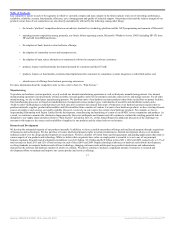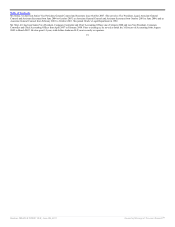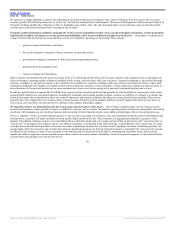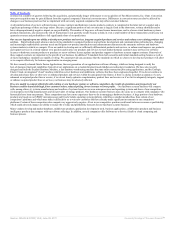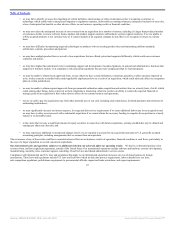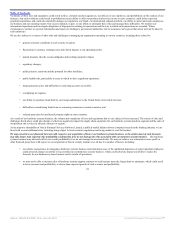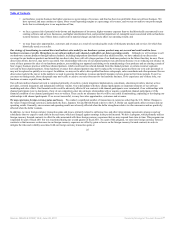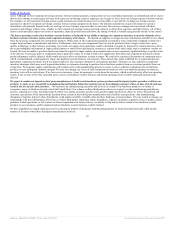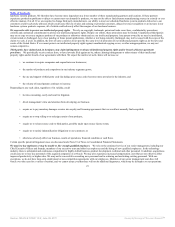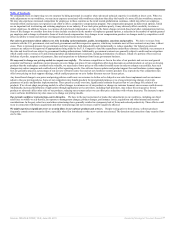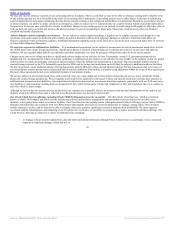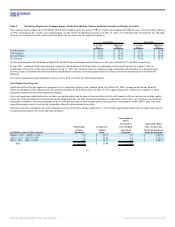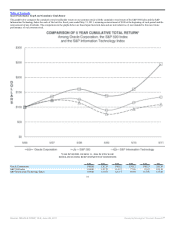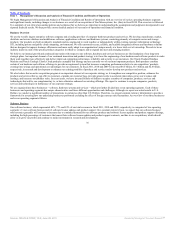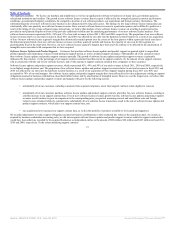Oracle 2010 Annual Report Download - page 31
Download and view the complete annual report
Please find page 31 of the 2010 Oracle annual report below. You can navigate through the pages in the report by either clicking on the pages listed below, or by using the keyword search tool below to find specific information within the annual report.
Table of Contents
hardware systems products. We therefore have become more dependent on a fewer number of these manufacturing partners and locations. If these partners
experience production problems or delays or cannot meet our demand for products, we may not be able to find alternate manufacturing sources in a timely or cost
effective manner, if at all. If we are required to change third party manufacturers, our ability to meet our scheduled hardware systems products deliveries to our
customers could be adversely affected, which could cause the loss of sales and existing or potential customers, delayed revenue recognition or an increase in our
hardware systems products expenses, all of which could adversely affect the margins of our hardware business.
We may not be able to protect our intellectual property rights. We rely on copyright, trademark, patent and trade secret laws, confidentiality procedures,
controls and contractual commitments to protect our intellectual property rights. Despite our efforts, these protections may be limited. Unauthorized third parties
may try to copy or reverse engineer portions of our products or otherwise obtain and use our intellectual property. Any patents owned by us may be invalidated,
circumvented or challenged. Any of our pending or future patent applications, whether or not being currently challenged, may not be issued with the scope of the
claims we seek, if at all. In addition, the laws of some countries do not provide the same level of protection of our intellectual property rights as do the laws and
courts of the United States. If we cannot protect our intellectual property rights against unauthorized copying or use, or other misappropriation, we may not
remain competitive.
Third parties have claimed and, in the future, may claim infringement or misuse of intellectual property rights and/or breach of license agreement
provisions. We periodically receive notices from, or have lawsuits filed against us by, others claiming infringement or other misuse of their intellectual
property rights and/or breach of our agreements with them. We expect the number of such claims will increase as:
• we continue to acquire companies and expand into new businesses;
• the number of products and competitors in our industry segments grows;
• the use and support of third party code (including open source code) becomes more prevalent in the industry; and
• the volume of issued patents continues to increase.
Responding to any such claim, regardless of its validity, could:
• be time consuming, costly and result in litigation;
• divert management’s time and attention from developing our business;
• require us to pay monetary damages or enter into royalty and licensing agreements that we would not normally find acceptable;
• require us to stop selling or to redesign certain of our products;
• require us to release source code to third parties, possibly under open source license terms;
• require us to satisfy indemnification obligations to our customers; or
• otherwise adversely affect our business, results of operations, financial condition or cash flows.
Certain specific patent infringement cases are discussed under Note 18 of Notes to Consolidated Financial Statements.
We may lose key employees or may be unable to hire enough qualified employees. We rely on the continued service of our senior management, including our
Chief Executive Officer and founder, members of our executive team and other key employees and the hiring of new qualified employees. In the technology
industry, there is substantial and continuous competition for highly skilled business, product development, technical and other personnel. In addition, acquisitions
could cause us to lose key personnel of the acquired companies or at Oracle. We may also experience increased compensation costs that are not offset by either
improved productivity or higher sales. We may not be successful in recruiting new personnel and in retaining and motivating existing personnel. With rare
exceptions, we do not have long-term employment or non-competition agreements with our employees. Members of our senior management team have left
Oracle over the years for a variety of reasons, and we cannot assure you that there will not be additional departures, which may be disruptive to our operations.
27
Source: ORACLE CORP, 10-K, June 28, 2011 Powered by Morningstar® Document Research℠


